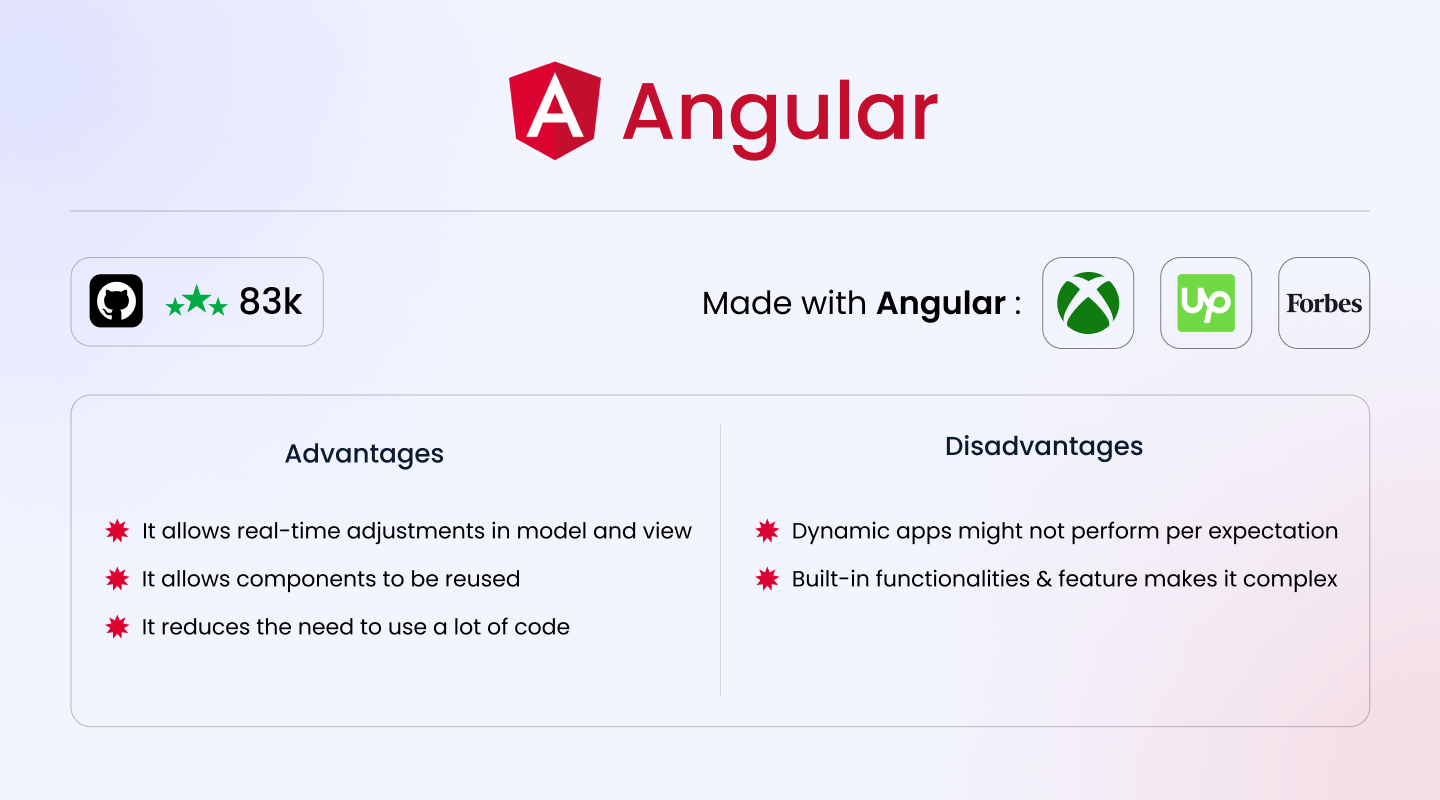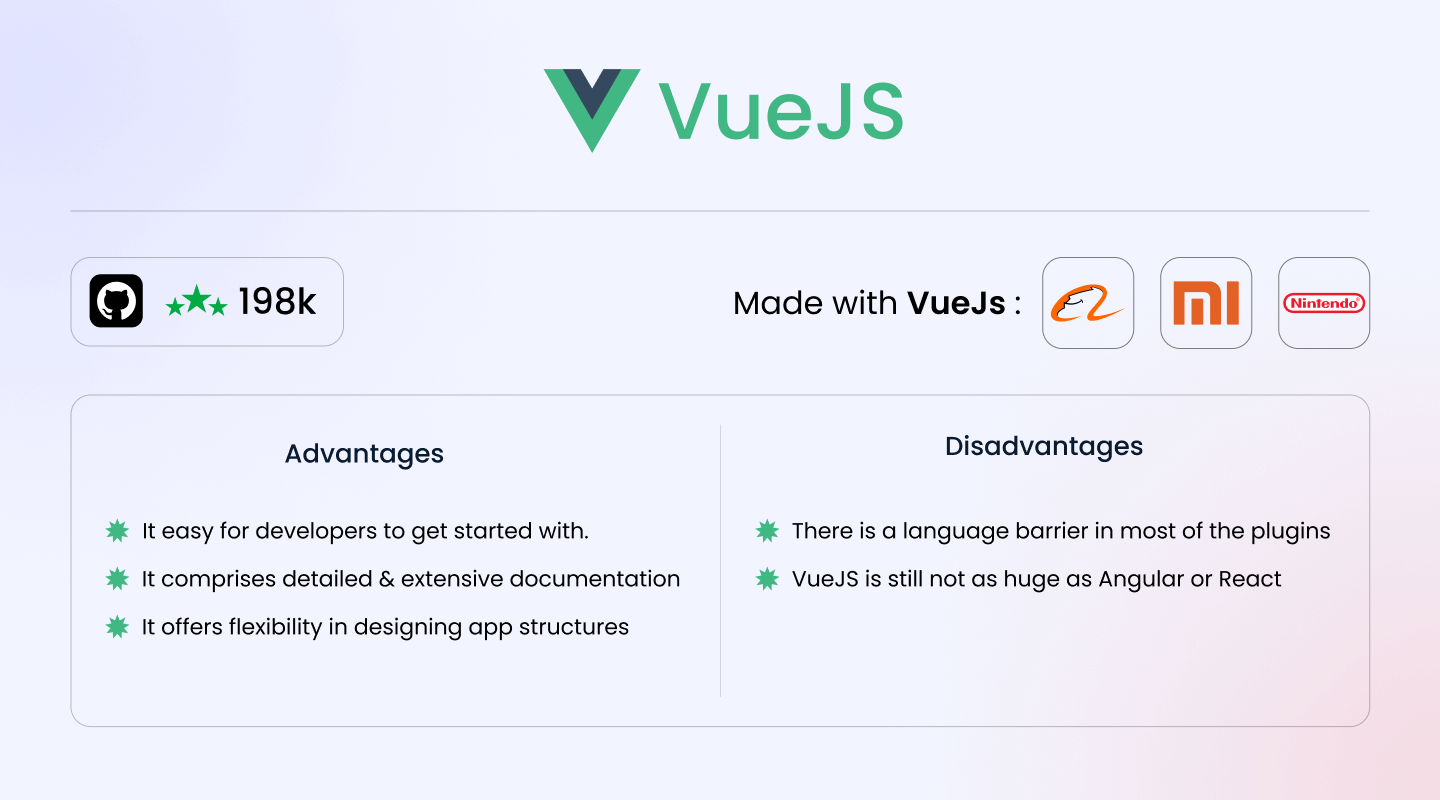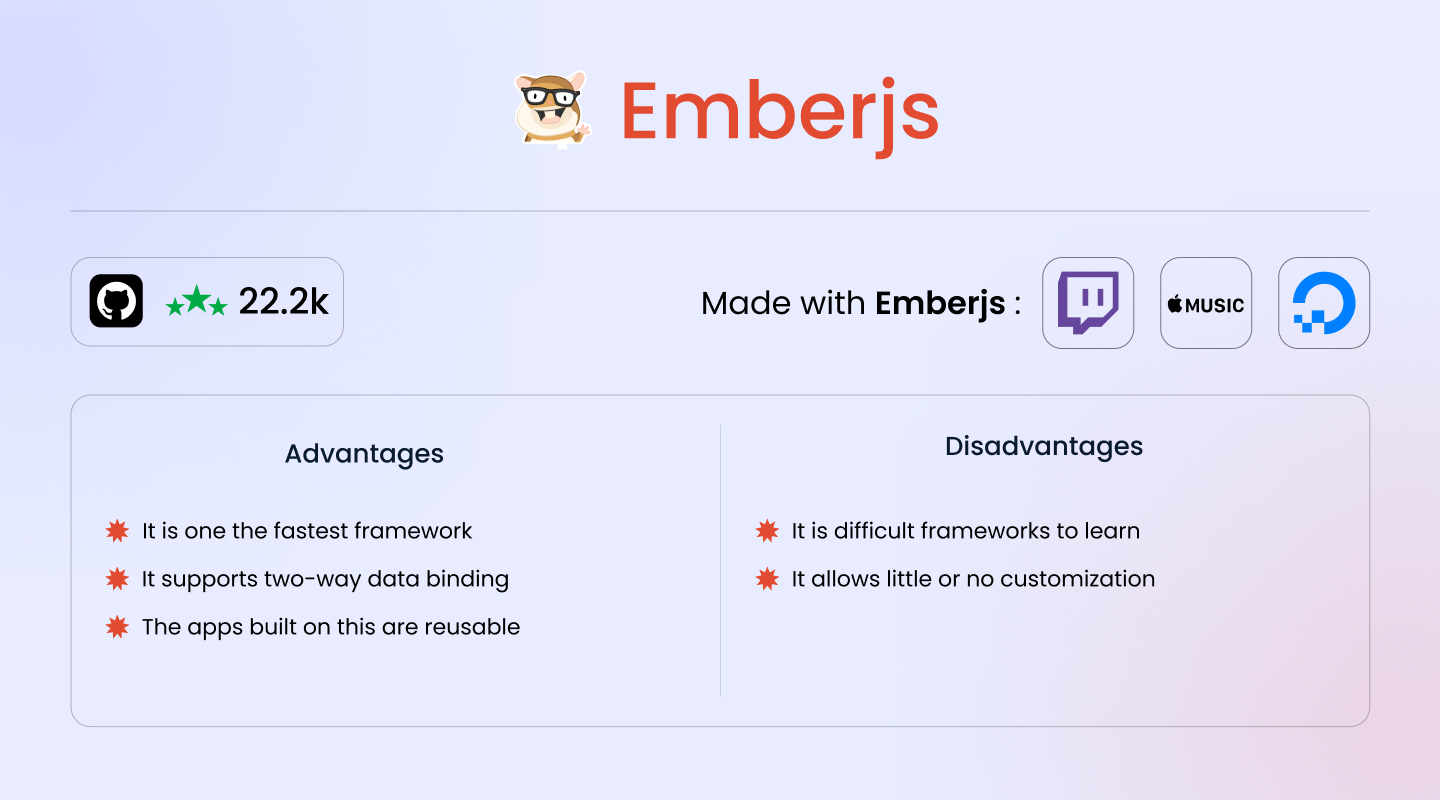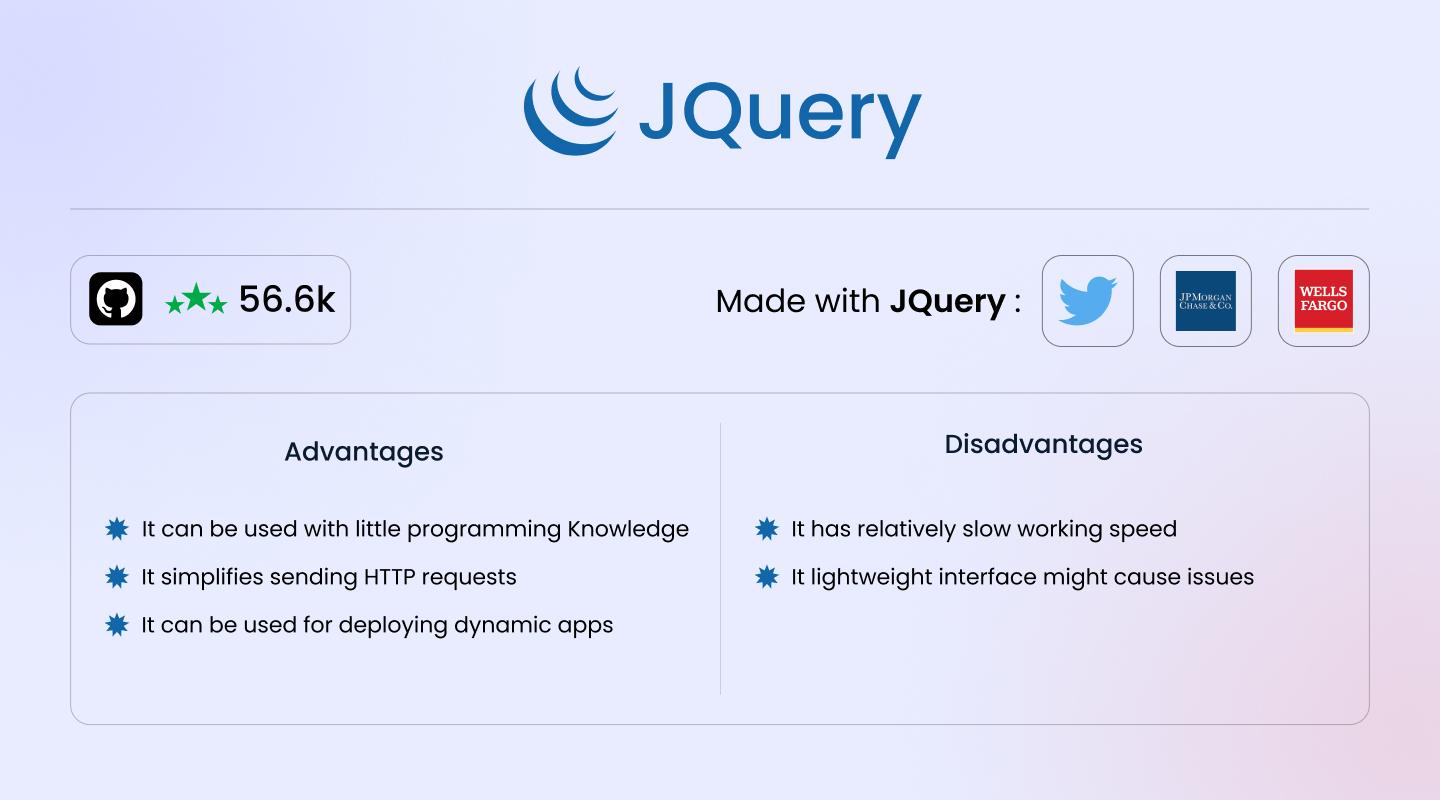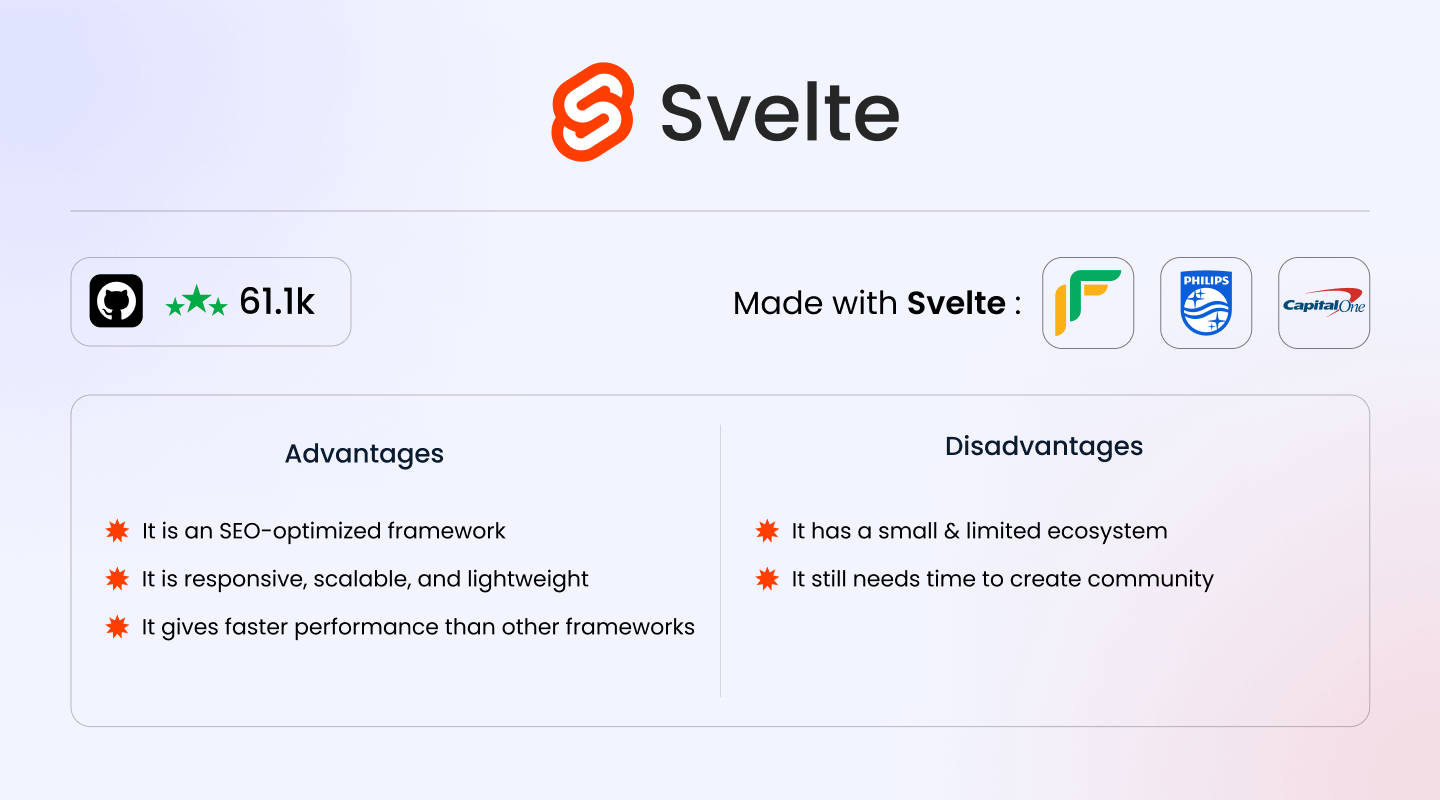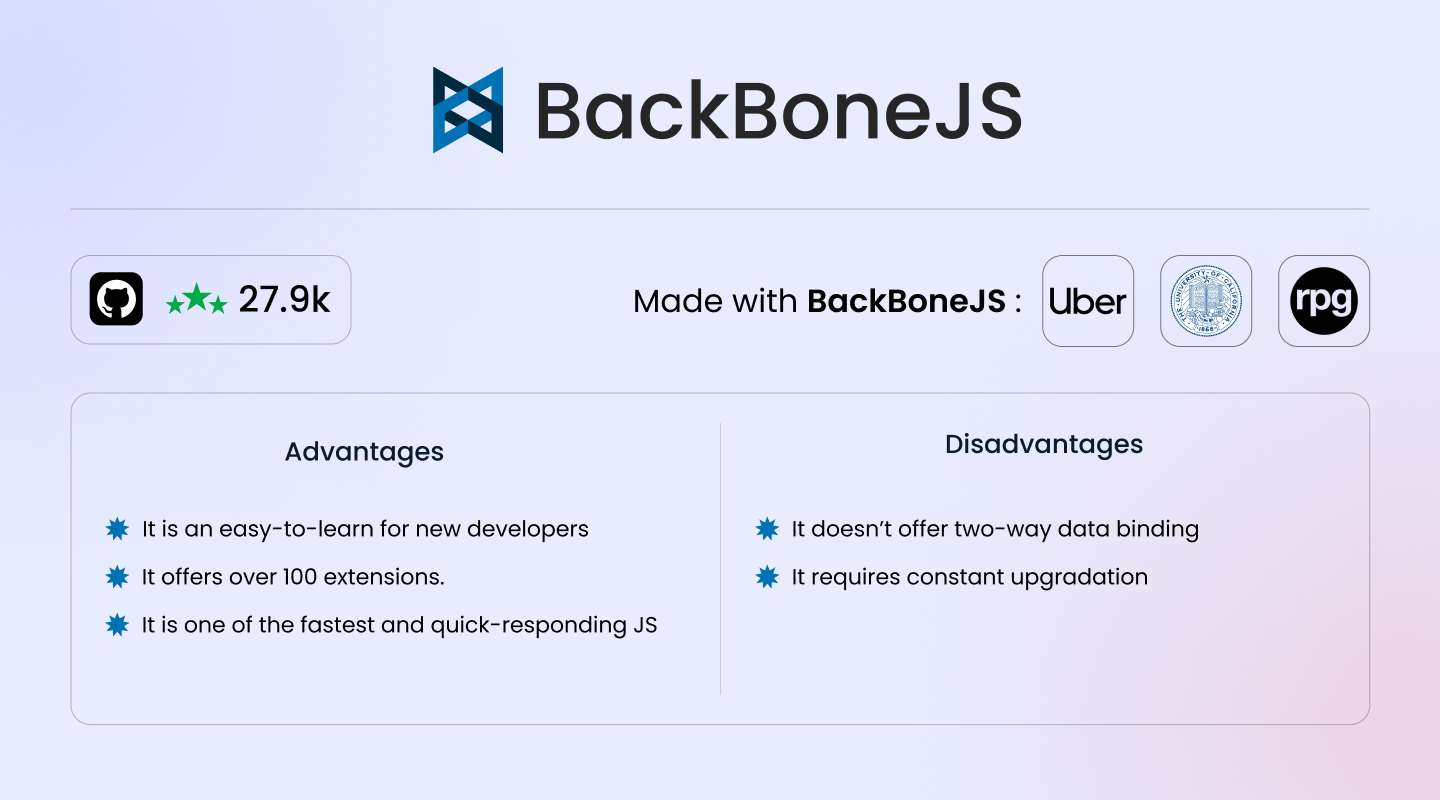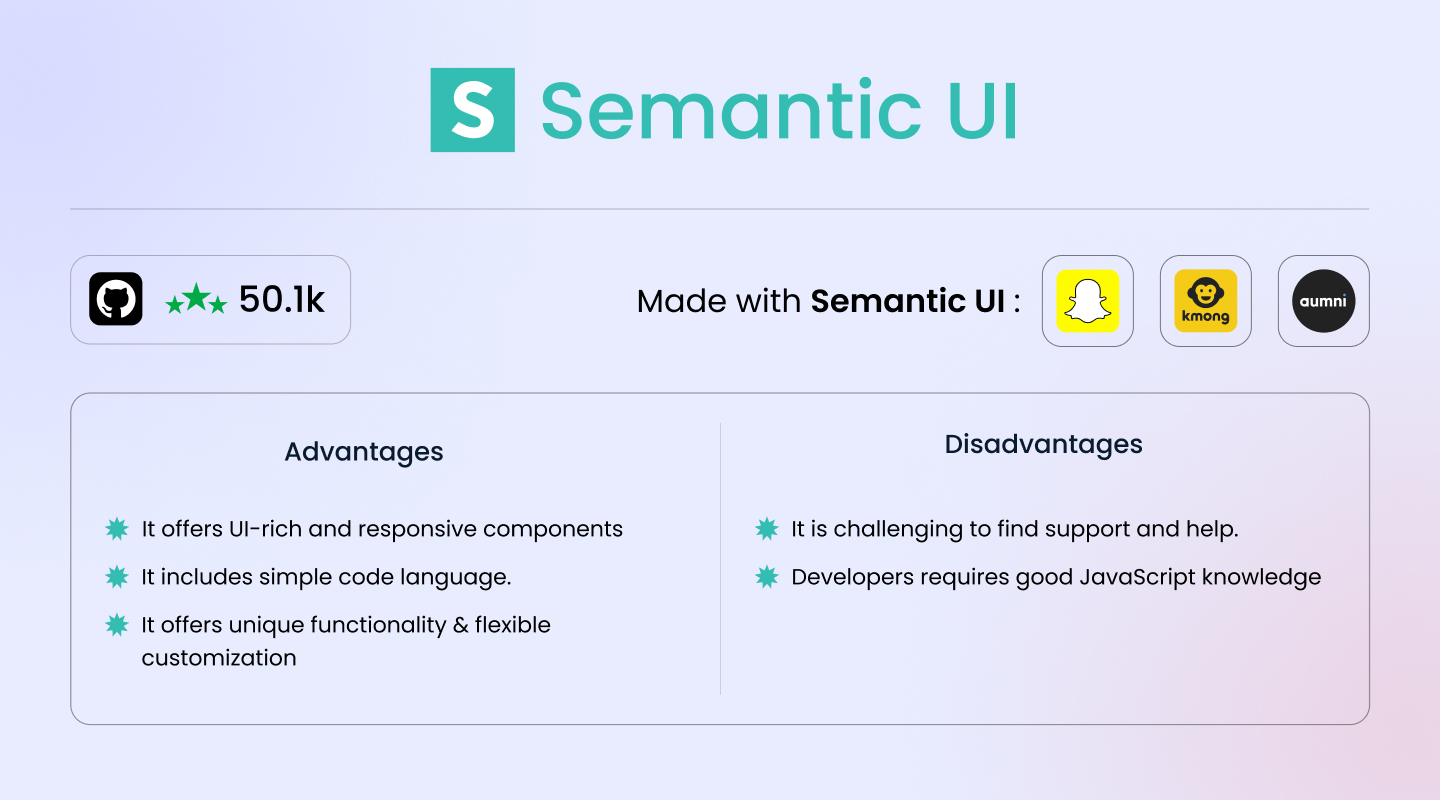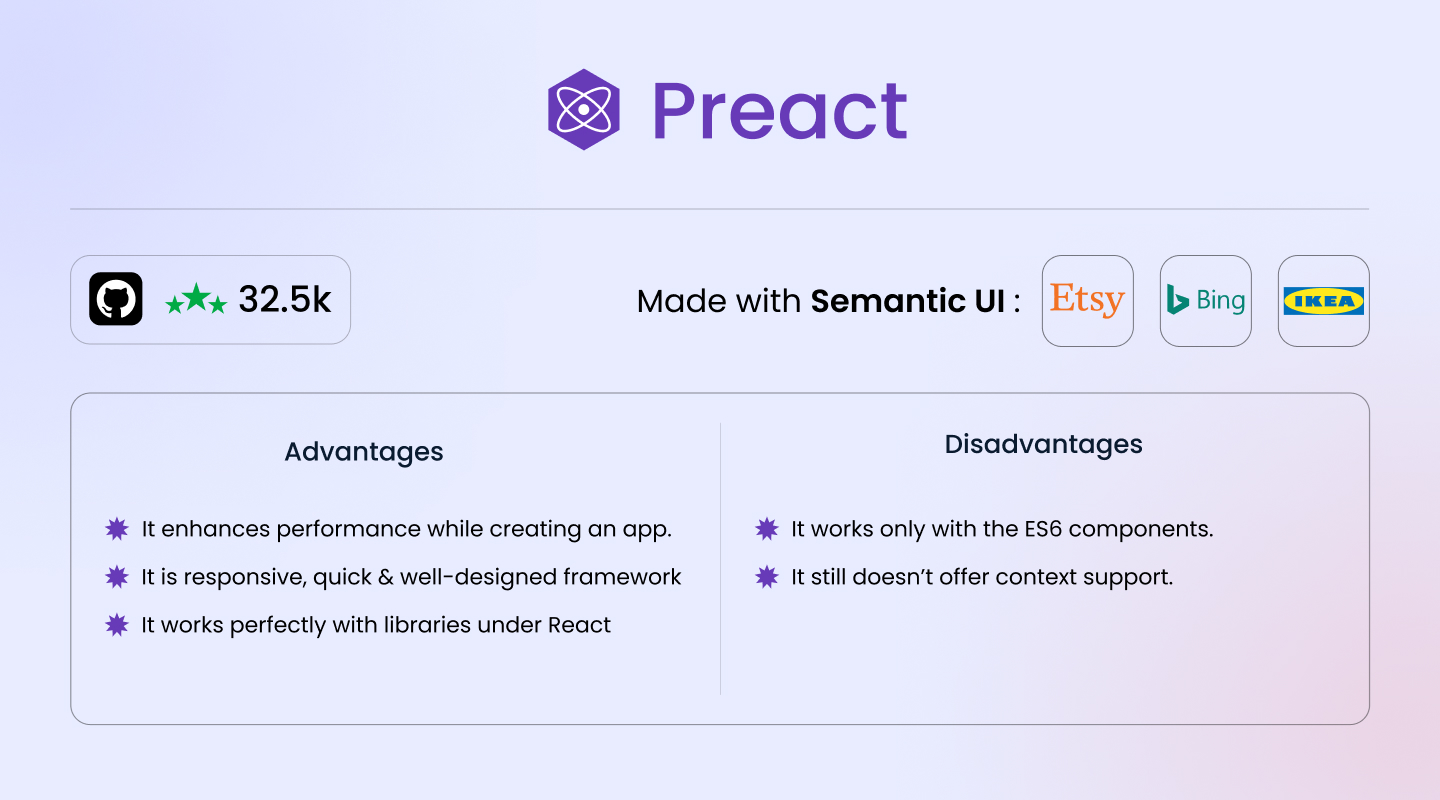Quick Summary :- Even if your website's backend is well-developed, the frontend is something the user encounters first and plays a major role in the UX (User Experience). Hence, you must make your web frontend as appealing as possible to meet user expectations. Wondering how? This post on the best frontend frameworks for app and web development will help you reach there.
As users want faster and more intuitive online experiences, websites need to load fast and have visually appealing, seamless interactions. The frontend framework you choose is key to meeting those expectations and shaping the user’s journey from the very first interaction.
According to the 2024 Stack Overflow Developer Survey, React.js is the most popular frontend framework with 39.5% of developers using it. Vue.js is close behind at 15.4%, and Svelte has gained a lot of traction with 6.5% adoption.
This article will cover the 10 best frontend frameworks in 2025, pros and cons, and use cases. Whether building dynamic apps or content heavy sites, choosing the right framework is key to success.
Top Front-End Frameworks in 2025 (Quick Comparison Table)
This table ranks the most popular front-end frameworks based on GitHub stars, highlighting their best uses and key adopters.
| Framework | Best For | GitHub Stars | Used By |
| React | SPAs, PWAs, reusable components | 236K | Facebook, Netflix, Uber |
| VueJS | Fast, lightweight web apps | 209K | Adobe, GitLab, Xiaomi |
| Angular | Scalable enterprise applications | 97.8K | Gmail, Microsoft, Upwork |
| Svelte | SEO-friendly, minimal runtime | 82.7K | Razorpay, GoDaddy |
| jQuery | Legacy projects, simple scripting | 59.5K | Twitter, Uber, Wells Fargo |
Here is the list of Top Frontend Frameworks For Web Development
React: Ideal JavaScript library for Enticing User Interfaces
Created and maintained by Facebook, React.js is an open-source JavaScript-based framework for developing interactive user interfaces. It is a popular framework because of its ease of usage and flexibility. As per Statista, React ranks second among the most used frontend frameworks worldwide as of 2024, with 39.5% of developers actively using the framework.
One of the unique features of React is the VDOM (Virtual Document Object Model) and how well it handles document manipulation and access. Additionally, React has a vast active community, allowing developers to access a broad range of support and resources.
Pros:
- React lets you reuse components in your code. That makes collaboration and reusing these components easy in other areas of the app.
- The use of VDOM helps in the app’s seamless performance and ascertains that even a high-loading app has a fast-rendering speed.
- It boosts productivity. New changes or modifications in the app can be made easily.
- The React Developer Tools provide developers with advanced tools for optimizing their work.
Cons:
- React does not offer backend solutions.
- The developers often face challenges in understanding the concepts related to JSX during the initial stage of working with React.
- The constant component updates make it difficult for developers to maintain accurate documentation.
When to use React?
React is mainly used for creating PWAs (progressive web apps) and single-page web apps. However, it’s the go-to framework for developing interactive UI for an application in less time, as the components can be reused easily.
When not to use React?
Since JSX can be quite difficult to learn, new developers are highly advised not to use this framework. Besides, React is not the best option for those who do not have hands-on knowledge of JavaScript.
GitHub Stars:
Used By:
PayPal, Netflix, Groupon, Uber, Walmart, Microsoft, eBay, Facebook, Instagram, Google, Pinterest, LinkedIn, Dropbox, etc.
Angular: Typescript-Based library for Interactive Web Apps
Angular is the only transcript-based framework that makes a spot in our best frontend frameworks list. Created and maintained by Google, Angular is a complete solution when it comes to developing complex web apps. It offers improved technology and is a powerful template language.
Like React, Angular is an open-source JavaScript framework for developing UIs on the frontend. However, the major difference between Angular and React is the two-sided data binding feature in Angular. This feature allows real-time synchronization of views and models. It works either way; therefore, changes made in the model will also reflect in view, and vice-versa.
Angular is generally used to develop web and mobile apps. Besides, it can also be used in the development of multi-page and single-page apps.
Pros:
- Angular’s in-built functionality allows real-time upgrade adjustments in both model and view. That lowers the room for any error.
- Components can be reused however required as the developers can decouple the interdependent components using dependency injectors.
- It reduces the need to use a lot of code as most significant features, like two-way binding, are offered by default.
- A big developer community uses Angular worldwide, making it easy for developers to seek help and support if they face an issue.
- You can integrate Angular with an array of third-party tools.
Cons:
- Dynamic apps can suffer sometimes and might not perform per expectation.
- The wide variety of built-in functionalities and features makes learning the Angular framework a little complex.
When to use Angular?
Angular is the ideal option for dynamic and enterprise-based apps because of its two-way binding feature that allows web browser-based apps to augment.
When not to use Angular?
Opting for Angular to create small-scale apps wouldn’t be the best choice as you won’t use its resources at their true potential. It will be a complete misuse of resources and time. Moreover, avoiding complex frameworks such as Angular is best if you have a small developer team.
GitHub Stars:
Used By:
Xbox, Forbes, Gmail, Mixer, Blender, PayPal, Upwork, Deutsche Bank, Microsoft Office, Santander, etc.
VueJS: Modern Framework for Single-page applications
Next on our list of the best front end frameworks is VueJS, a straightforward and consistent framework. VueJS is not as complex as Angular, making it extremely easy to use and learn. Besides, it’s small in size and, like Angular, provides two-way data binding. Additionally, VueJS also offers component-based and Visual DOM programming.
You can easily build small and dynamic web apps using VueJS. However, in spite of being versatile, the framework is not that popular among large-scale companies. That’s because big-scale companies trust Angular for building enterprise-based apps. But still, VueJS continues to establish a strong market base despite a small number of takers in Silicon Valley.
Pros:
- VueJS’s simple syntax makes it easy for developers to get started with it.
- The framework comprises detailed and extensive documentation for beginners.
- VueJS has a positive effect on the app or website’s SEO.
- It offers flexibility to developers in designing app structures.
Cons:
- There is a language barrier as most of the plugins in VueJS are written in Chinese.
- Though it offers many features, VueJS is still not as huge as Angular or React.
- VueJS is in a growing stage still and thus doesn’t have a big community.
When to use VueJS?
VueJS is best for those projects that require greater flexibility. Developers can design every component from scratch, allowing them to design dynamic apps easily.
When not to use VueJS?
VueJS is not ideal for apps that need stable components. Besides, it does not have a support community where one can seek guidance in case of any hurdles.
GitHub Stars:
Used By:
Alibaba, Reuters, 9gag, Xiaomi, GitLab, Passionate People, Trivago, FindlayWebTech, BridgeU, Nintendo, Grammarly, Adobe, etc.
EmberJS: Productive JavaScript Framework for Modern Web Apps
EmberJS is among the best front end frameworks that assist in creating modern UIs for cross-platform, desktop and mobile apps. It resembles Angular with its two-way binding feature and component-focused functionality.
Developed in 2011, EmberJS is one of the most difficult frameworks to learn. However, it is still utilized by many large-scale companies as it lets developers create complex web and mobile apps easily. When using EmberJS, you can depend on its ever-growing community of talented developers to always improve and release new features.
Pros:
- EmberJS is one of the top frontend frameworks when it comes to speed. It is among the fastest framework available in the market.
- It supports two-way data binding.
- The apps developed using EmberJS are reusable.
- It helps developers keep well-written and proper documentation.
Cons:
- It is one of the most difficult frameworks to learn due to its conventional and rigid structure.
- EmberJS is a heavy framework for small-scale apps.
- It allows little or no customization.
- Working on EmberJS can be annoying sometimes, as it has a complex syntax.
When to use EmberJS?
Developers creating modern apps with a rich UI can use EmberJS. The framework is a complete front-end solution for big-scale projects since it offers useful binding, ready configuration, and personalized properties for rendering the page.
When not to use EmberJS?
EmberJS is not the best choice of framework for creating small apps, as most of its resources will not even be used. Besides, if your developer team size is small, try avoiding EmberJS as it might have a high initial cost. Also, this framework is not preferable for developing a simple UI.
GitHub Stars:
Used By:
Netflix, Tinder, Twitch, Groupon, DigitalOcean, Square, Accenture, Chipotle, Apple Music, Nordstrom, Blue Apron, LinkedIn, Yahoo!, PlayStation Now, Vine, etc.
JQuery: Feature-rich Library to simplify JavaScript programming
JQuery is among the oldest and most popular front end frameworks. It is a feature-rich, fast and simple framework that’s easy to use and learn. With this framework, one does not have to write excessive JavaScript codes.
One of the best aspects of JQuery is its development into an enhanced version of itself every day. As its API works across various browsers, JQuery helps simplify tasks such as animation, Ajax, document manipulation, and traversal. Besides, with the recent JQuery Mobile development, developers can create mobile apps now, which wasn’t possible initially.
Pros:
- Even those having little knowledge of programming language can use JQuery easily.
- JQuery has a flexible DOM that helps in removing or adding components.
- It simplifies sending HTTP requests.
- Despite being simple, JQuery can be used for deploying dynamic apps.
Cons:
- JQuery has a relatively slow working speed.
- Other than JQuery, there are several advanced alternatives available out there.
- JQuery’s lightweight interface might cause issues in the long run.
When to use JQuery?
JQuery can be your best bet when creating desktop-based JavaScript apps. It maintains a simple and concise code structure.
When not to use JQuery?
Using JQuery when creating large-scale apps is not advisable, as the extensive JavaScript code can make the app heavy. Besides, despite being one of the best front end frameworks, JQuery cannot compete with the latest frameworks that require less coding and can reuse the components.
GitHub Stars:
Used By:
Twitter, Uber, JPMorgan Chase, Walt Disney, Edward Jones, Wells Fargo, QTC Management, etc.
Svelte: Modern Approach towards Building Rich User Interfaces
Svelte is among the trending frontend frameworks. It is a JavaScript compiler that has been designed to create high-end UIs. Svelte does not employ VDOM. Instead, this framework uses a particular ‘JavaScript Virtual Machine’ that’s designed to develop UIs.
That enables this framework to be 10x times faster and more responsive than other frameworks like React and Angular. However, learning Svelte can be challenging due to its distinct working style. But the time spent on Svelte can provide amazing results for those who intend to dive deeper into this framework.
Pros:
- Svelte is an SEO-optimized framework.
- It offers faster performance than the other frameworks.
- It is responsive, scalable, and lightweight.
- Svelte requires minimal coding.
Cons:
- Svelte has a small, limited ecosystem and offers limited tools.
- It still needs time to create a strong support community.
- It’s not one of the most popular front end frameworks among developers yet.
When to use Svelte?
Svelte is ideal for small-scale projects being developed by a small developer team. Besides, it is a good choice for beginners because of its less load time and simple syntax. That helps speed up the app or web product.
When not to use Svelte?
The developers working on large-scale apps or websites should avoid Svelte. This framework provides limited tooling and is, therefore, not widely used. Besides, you might not be able to find the help you need in later development stages owing to its small support community.
GitHub Stars:
Used By:
Cashfree, Philips BlueHive, GoDaddy, Chess, HealthTree, Razorpay, Rakuten, Capital One, GoGuardian, etc.
BackBoneJS: Structuring Client-Side Web Applications
BackBoneJS is one of the top frontend frameworks for creating small-sized, single-page apps. It follows the MVC architecture that helps with swift app development. The MVC View allows you to implement logic in the components easily.
BackBoneJS has been correlated with various engines such as Moustache and underscoreJS. If you create an app using BackBoneJS, you might also want to utilize tools like Chaplin, Marionette, Handlebars, or Thorax to make the most of this framework.
It is a fast-growing and versatile framework and an amazing choice for both backend and frontend development. Its REST API offers a smooth synchronization between frontend and backend, letting you utilize the framework on either of the two.
Pros:
- BackBoneJS is an easy-to-learn framework for new developers.
- It offers over 100 extensions.
- BackBoneJS is one of the fastest and quick-responding JavaScript-based frameworks.
- There are detailed, well-organized tutorials available.
- The framework stores the data as models rather than storing them in DOM.
Cons:
- BackBoneJS doesn’t offer two-way data binding.
- Developers might have to write more code.
- It requires constant upgradation with ever-evolving technology.
- Its architecture can be confusing at times.
When to use BackBoneJS?
BackBoneJS is a good choice for creating apps that need dynamic management of updates, constant server synchronization, etc. You can reuse and update the codes easily.
When not to use BackBoneJS?
BackBoneJS is not preferable if you aim to have several features in a single framework. However, you can download plugins and extensions for extending the features of BackBoneJS.
GitHub Stars:
Used By:
Walmart, Uber, Racepoint Global, Pinterest, AMC Networks Inc, Reddit, McCorkell & Associates Pty. Limited, Master Card, Roblox, LinkedIn, University of California, etc.
Semantic UI: Feature-rich Framework for intuitive User Interfaces
Though Semantic UI is relatively new in the frameworks zone, it is still making its way to being one of the best front end frameworks. The simplicity, usability, and seamless UI are the major reason for its success. Semantic UI incorporates self-explanatory organic codes, which makes it easy for new developers to work with it.
Moreover, Semantic UI follows a simple app and web development process because of its collaboration with several 3rd-party libraries. That makes this framework an incredible development platform.
Pros:
- Semantic UI includes simple code language.
- It offers UI-rich and responsive components.
- It has an amazing collection of themes.
- Semantic UI offers unique functionality and a flexible customization system.
Cons:
- Semantic UI is still not widely used, making it challenging to find support and help.
- It demands competency in designing customized configurations.
- Semantic UI is not suitable for developers who do not have JavaScript knowledge.
When to use Semantic UI?
Semantic UI is an incredible platform for designers and developers who want lightweight, seamless, responsive UIs.
When not to use Semantic UI?
Semantic UI is not advised for developers not experienced in creating customizations sans depending on ready-made functionalities.
GitHub Stars:
Used By:
Accenture, Snapchat, Kmong, Aumni, Digital Services, Modanisa, Ovrsea, etc.
Foundation: Responsive Framework to achieve Mobile-first Approach
Although Foundation is a framework meant for experienced developers, it’s fruitful and impressive to work around it once you’re well-acquainted with the framework. Foundation was created by Zurb to develop enterprise-level apps and websites.
Foundation offers GPU acceleration for smooth animations and quick mobile rendering facilities. Besides, it also provides heavy sections for larger devices. Foundation is the right combination of components any developer desires. Leading tech giants like Microsoft and eBay have been using this framework successfully.
Pros:
- Foundation has features enabling the development of appealing and exclusive websites.
- It provides flexibility in utilizing grids.
- It offers customized UX for different media and devices.
Cons:
- Foundation has limited community and support forums because of its complex design.
- It faces tough competition from other popular frontend frameworks.
- It is not an easy-to-learn framework for beginners.
When to use Foundation?
Foundation is one the best frontend frameworks for developers with experience and knowledge of it. It’s an ideal framework for developing a mobile-friendly and visually appealing website or app with a customized UX.
When not to use Foundation?
Fresher or beginner developers should skip using Foundation as changing the code is challenging, which might create difficulties during development.
GitHub Stars:
Used By:
eBay, Firefox, Harvard University, etc.
Preact: Ideal Library for Progressive Web Apps
Though React is one of the best front end frameworks, it has certain limitations. For this reason, the idea to create a small, lightweight framework with features similar to React arose. That’s how a mini variant of React, Preact, was discovered.
Both, Preact and React have similar APIs and utilize similar development techniques. However, Preact is much more compact than React and renders the fastest VDOM possible. That makes it a popular frontend framework choice for app development among developers.
Be it a new or existing project, this framework can help save you a lot of time owing to its powerful CLI. Besides, Preact is the best choice if you plan on developing a small app with no complicated integrations.
Pros:
- Preact enhances performance while creating an app.
- It is small in size (3kb).
- You can learn and implement the codebase easily.
- It works perfectly with several libraries under React ecosystem.
- Preact is a responsive, quick, and well-designed frontend framework.
Cons:
- Preact has a small support community owing to less popularity.
- It doesn’t support propTypes, one of React’s salient features.
- Preact works only with the ES6 components.
- It works with web browser API, offering no support for synthetic event use.
- It still doesn’t offer context support.
When to use Preact?
Preact is ideal for developers worried about performance, speed, and size. It’s the right choice for designing advanced apps with small widgets and simple UIs. If the website or app targets users wanting short load time, Preact makes the perfect option.
When not to use Preact?
Many companies still prefer React, so switching to Preact could cause issues as they may lose certain important React features. Besides, Preact shouldn’t be considered for developing heavy or complex apps as that’ll lead to downloading additional packages.
GitHub Stars:
Used By:
Etsy, Uber, Bing, IKEA, etc.
Factors to Consider when Shortlisting Front End Frameworks
Shortlisting the most popular front end frameworks is challenging as each framework is unique in its own way. Hence, here are three factors that can help make your decision-making process a little easier.
Kind of app or website you intend to develop:
You will need a web framework based on the type of website or app you want to develop. A small-scale vs. a large-scale app will require varied features; thus, you must pick a framework accordingly.
Easy and simple to use frameworks:
Developers work on numerous projects at a time, and therefore, they require simple frameworks. Hence, new developers opt for easy frameworks over complicated ones to be at par with the competition and offer better results to the clients.
Budget-friendliness:
The developers prefer to work with the best frontend frameworks that provide the finest features at cost-effective prices. Such frameworks help them generate more revenue and so are popular.
Conclusion
As you can see, all frontend web frameworks come with their pros and cons. If one framework works for a particular project, the other, although a good tool, could be completely inappropriate. Therefore, you should determine your project requirement before you begin the development and then choose a framework.
Choose the Right Front-End Framework with eSparkBiz
Selecting the right front-end framework is key to your web app’s performance and user experience. At eSparkBiz, we help businesses choose and implement frameworks like React, Vue.js, Angular, and Next.js based on project goals, scalability and performance requirements.
Our team of 90+ developers delivers responsive, high performing interfaces for small MVPs or large enterprise platforms.
Our focus:
- Custom UI development for better user engagement
- Framework selection based on your tech stack
- Reusable codebases for long term growth
- Performance optimization for faster apps
Connect with us today to onboard the best frontend developers!
-
Which frontend frameworks are ideal for small-scale web apps?
Creating small-scale web apps requires lightweight frontend frameworks like BackBoneJS, JQuery, etc.
-
Which frontend web frameworks can be used for developing large web apps?
Developing large web apps requires the utilization of a feature-rich framework that's backed by considerable communities. Some such frameworks are React, Angular, EmberJS, and VueJS.
-
When should I consider using a frontend framework?
It's wise to use the best front end frameworks when your project requires swift development and a dynamic UI.
-
Which is the best frontend framework?
There are several top frontend frameworks available in the market today. However, not all can be the right fit for every project. It would be best to choose a framework depending on your project scale and requirement. The highly used and most popular frontend frameworks are Angular, React, JQuery, and VueJS, as per the no. of developers using them currently.



